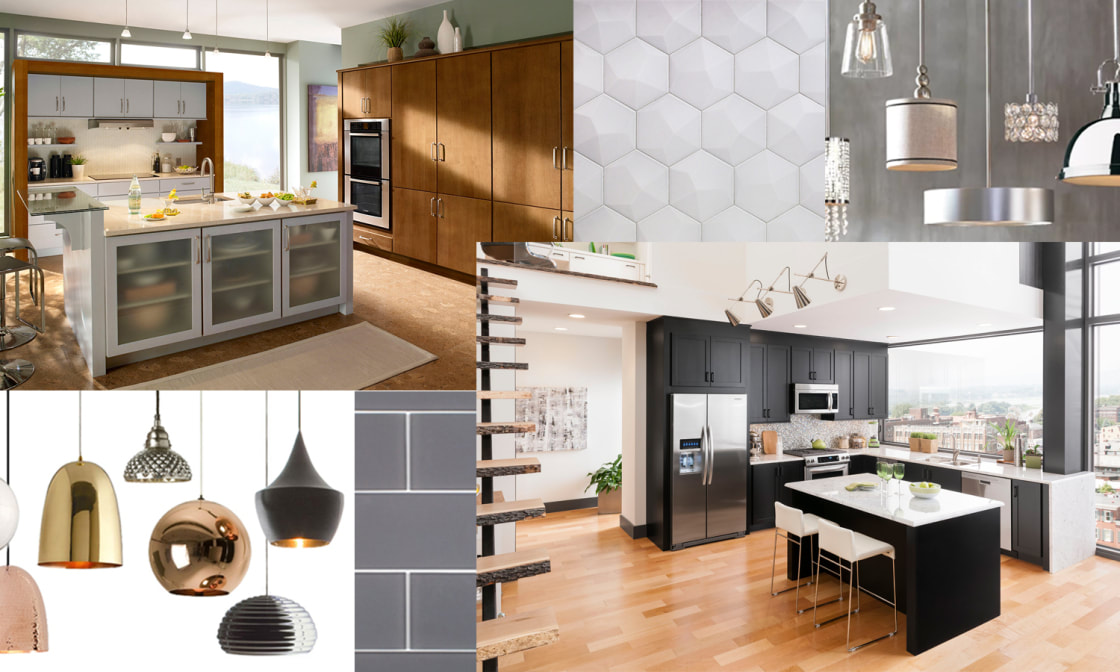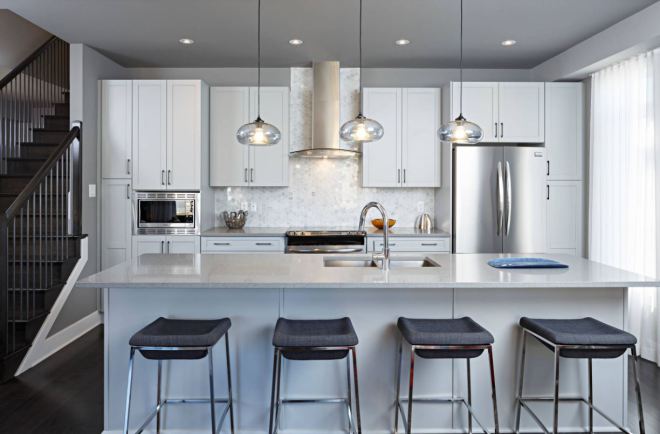|
Featured from Sips and Tips By Medallion Cabinetry Ever wonder what is the difference between a modern or contemporary kitchen? And does it seem that these two terms end up getting lumped together in the same category? I certainly have had my share of questions about the two styles and thought it might be a good idea to get into the differences – without getting into the entire history. As designers, we tend to use both “modern” and “contemporary” to talk about the same sleek, trendy look. To complicate things even more, Modern and Contemporary designs include simple, uncluttered spaces, smooth, clean lines, and high-fashion, artistic flair. But in spite of their similarities, it’s helpful to break down some of the differences to make sure we can understand what clients are looking for. THE POPULAR VOTE - The 2017 Houzz study pointed out some key trends relating to these style groups that designers should keep in mind. First of all, interest in Contemporary style is growing for consumers. 27% of the homeowners surveyed changing the style of their kitchen chose Modern or Contemporary looks. The NKBA also highlighted that trend in their 2018 survey of designers: 73% agreed that Contemporary is one of the top three trending styles in kitchens, along with either Farmhouse and Transitional. (Kitchen and Bath Design Trends January 2018, pg. 10). Since the line between Modern and Contemporary is a little unclear even for professionals in the kitchen and bath field, imagine how much blurrier it is for the average consumer! It’s important to clarify what your client means when they say “modern” or “contemporary” to make sure you’re on the same page. Especially when the image results within each category are a mixed bag. I’ve seen some very minimalist transitional spaces called modern or contemporary simply because they feature a lot of white cabinetry or contemporary hardware, fixtures and tile. CONTEMPORARY STYLE HIGHLIGHTS:
In the bullet points above the photo, I call out slab door styles as a staple for Contemporary designs. But as we look at the above photo we see a Shaker style door instead. Does that make the design fit better into Contemporary or would you categorize it as Transitional? In Contemporary design, it is as much about the architecture as it is about the fittings. Notice the color blocking (ceiling and walls), the tall window and the soffit along the far wall? Then there’s the contrast of dark, almost black, stain to bright white. And of course the railing on the stairs – simple, minimal and made from metal. These are all elements that make the room appear more contemporary. Beyond the architecture, it’s also the design selections that make this kitchen fit into a contemporary category. Lighting, backsplash tile, metal hood, faucet, counter stools, linear hardware and of course, a white simple style for the cabinetry. SO WHAT’S THE DIFFERENCE BETWEEN MODERN AND CONTEMPORARY? MODERN - A little over a century ago, "Modern Style” describes a set historical design period and it’s far older than you might think! This design style began over a hundred years ago as the design and decor of the Modernism movement. It was born out of the German Bauhaus school of design way back in at the turn of the 19th century and gained a lot of ground from Scandinavian emphasis on simplicity and function over the last century. Eventually, Modern Style morphed into Mid-century Modern style from the 1920's to 1950's. So, when you’re thinking about a “Modern” style, picture the work of famous Modern architect/designers like Ray and Charles Eames, or Frank Lloyd Wright. Modern Style highlights:
Contemporary - Part of the reason Contemporary and Modern get confused is that Contemporary blends elements of a number of different styles including Modern style. But Contemporary also includes elements of Art Deco, Minimalism, Deconstructivism, Futurism, Postmodernism, and more. It’s a fluid category that changes as trends, lifestyles, and technology change. The dictionary definition of contemporary is, “marked by characteristics of the present period,” in other words, now. Advances in technology impact this category the most as new materials are developed to emulate natural finishes, with the goal in mind to include other benefits, such as eaier, low user maintenance, and controlled colors/patterns. As a category, Contemporary style became popular in the 1970s and was simply seen as a blending of styles until it became a separate, recognizable style of its own. Contemporary style is very much about being on the forefront of fashion in design and décor and I believe it is growing in popularity for the fact that it is more flexible than Modern style yet offers a sleek and stylish look. Although Contemporary is often associated with frame less, European-style cabinetry, it’s very possible to achieve a contemporary look with framed cabinets, too. Take a look at these options from Medallion that fit this category: The key is to use clean and simple doors styles in paint or wood finishes, along with glass front and metal framed doors for creating contrast and showing the latest in material options. Decorative hardware is either minimal (like the tab pull) or super-stylish with linear emphasis. Counters vary throughout a design – in both material and thickness. European trends are showing counters super thin, in materials like Dekton and Lapitec. Appliances are best fully integrated or counter depth. (Clean lines, avoid “in and out” and drastic depth changes.) Lighting and plumbing fixtures impact the overall design as well of course and have a distinct look that is clearly contemporary. A WORD ON SHAKER STYLE With all this information on Contemporary and Modern style, it seems that Shaker style would be part of the conversation. Is it Modern? Is it Contemporary? In fact, it is a style category of its very own, similar to Mission style. All four of these styles are guided by the principles of simplicity and function which is their common thread. But Shaker style cabinetry in today’s home is primarily assigned to Transitional design. The framed door shape adds interest beyond a slab style and yet remains simple and clean, making it a great bridge between Modern, Contemporary and Traditional. To me, it hearkens back as a piece of the past and allows for the inclusion of today’s trending finishes. WHAT IT ALL BOILS DOWN TO In the simplest of terms, Modern is historical and defined, while Contemporary is in the now and evolving. In reality, I think it’s quite likely that the terms Contemporary and Modern will continue to be used interchangeably to describe a look, as most people are not as concerned about the true-ism of the terms. But by understanding the differences, you can aid in the interpretation and align your design with your client’s preferences by either working within the strict form of Modern or the more adaptable Contemporary style. For more amazing blog posts visit Suzannes amazing blog Sips and Tips
|
Search TopicsCategories
All
Follow Us |
|
Phone Numbers
Farmingdale:
(631) 957 - 6800 Smithtown
(631) 656 - 0936 |
Showroom Hours
|
Email & Social
|
Copyright © 2023 Lakeville Kitchen & Bath.
All Rights Reserved. Privacy Policy
Quality Cabinetry Since 1935.
All Rights Reserved. Privacy Policy
Quality Cabinetry Since 1935.





 RSS Feed
RSS Feed

